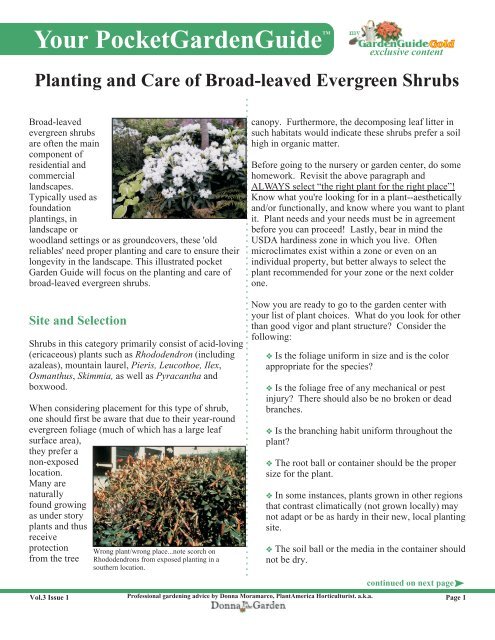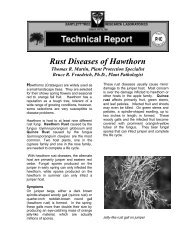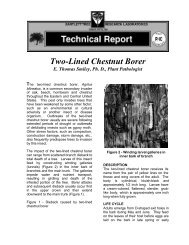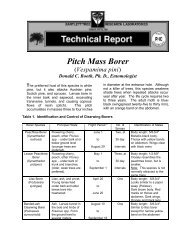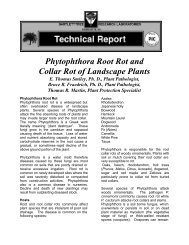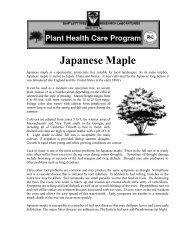Planting and Care of.. - Online Gardener
Planting and Care of.. - Online Gardener
Planting and Care of.. - Online Gardener
You also want an ePaper? Increase the reach of your titles
YUMPU automatically turns print PDFs into web optimized ePapers that Google loves.
TM<br />
Your PocketGardenGuide<br />
exclusive content<br />
<strong>Planting</strong> <strong>and</strong> <strong>Care</strong> <strong>of</strong> Broad-leaved Evergreen Shrubs<br />
Broad-leaved<br />
evergreen shrubs<br />
are <strong>of</strong>ten the main<br />
component <strong>of</strong><br />
residential <strong>and</strong><br />
commercial<br />
l<strong>and</strong>scapes.<br />
Typically used as<br />
foundation<br />
plantings, in<br />
l<strong>and</strong>scape or<br />
woodl<strong>and</strong> settings or as groundcovers, these 'old<br />
reliables' need proper planting <strong>and</strong> care to ensure their<br />
longevity in the l<strong>and</strong>scape. This illustrated pocket<br />
Garden Guide will focus on the planting <strong>and</strong> care <strong>of</strong><br />
broad-leaved evergreen shrubs.<br />
canopy. Furthermore, the decomposing leaf litter in<br />
such habitats would indicate these shrubs prefer a soil<br />
high in organic matter.<br />
Before going to the nursery or garden center, do some<br />
homework. Revisit the above paragraph <strong>and</strong><br />
ALWAYS select “the right plant for the right place”!<br />
Know what you're looking for in a plant--aesthetically<br />
<strong>and</strong>/or functionally, <strong>and</strong> know where you want to plant<br />
it. Plant needs <strong>and</strong> your needs must be in agreement<br />
before you can proceed! Lastly, bear in mind the<br />
USDA hardiness zone in which you live. Often<br />
microclimates exist within a zone or even on an<br />
individual property, but better always to select the<br />
plant recommended for your zone or the next colder<br />
one.<br />
Site <strong>and</strong> Selection<br />
Shrubs in this category primarily consist <strong>of</strong> acid-loving<br />
(ericaceous) plants such as Rhododendron (including<br />
azaleas), mountain laurel, Pieris, Leucothoe, Ilex,<br />
Osmanthus, Skimmia, as well as Pyracantha <strong>and</strong><br />
boxwood.<br />
When considering placement for this type <strong>of</strong> shrub,<br />
one should first be aware that due to their year-round<br />
evergreen foliage (much <strong>of</strong> which has a large leaf<br />
surface area),<br />
they prefer a<br />
non-exposed<br />
location.<br />
Many are<br />
naturally<br />
found growing<br />
as under story<br />
plants <strong>and</strong> thus<br />
receive<br />
protection<br />
from the tree<br />
Vol.3 Issue 1<br />
Wrong plant/wrong place...note scorch on<br />
Rhododendrons from exposed planting in a<br />
southern location.<br />
Now you are ready to go to the garden center with<br />
your list <strong>of</strong> plant choices. What do you look for other<br />
than good vigor <strong>and</strong> plant structure? Consider the<br />
following:<br />
❖ Is the foliage uniform in size <strong>and</strong> is the color<br />
appropriate for the species?<br />
❖ Is the foliage free <strong>of</strong> any mechanical or pest<br />
injury? There should also be no broken or dead<br />
branches.<br />
❖ Is the branching habit uniform throughout the<br />
plant?<br />
❖ The root ball or container should be the proper<br />
size for the plant.<br />
❖ In some instances, plants grown in other regions<br />
that contrast climatically (not grown locally) may<br />
not adapt or be as hardy in their new, local planting<br />
site.<br />
❖ The soil ball or the media in the container should<br />
not be dry.<br />
Pr<strong>of</strong>essional gardening advice by Donna Moramarco, PlantAmerica Horticulturist. a.k.a.<br />
continued on next page<br />
Page 1
TM<br />
Your PocketGardenGuide<br />
exclusive content<br />
<strong>Planting</strong> <strong>and</strong> <strong>Care</strong> <strong>of</strong> Broad-leaved Evergreen Shrubs<br />
Season to Plant<br />
Broad-leaved evergreen shrubs, being clothed all<br />
winter <strong>and</strong> thus more vulnerable to winter cold <strong>and</strong><br />
exposure, require good root establishment <strong>and</strong> aboveground<br />
hardening-<strong>of</strong>f prior to the arrival <strong>of</strong> winter.<br />
Any fall planting, which is fine for hardiness zone<br />
areas <strong>of</strong> 5 <strong>and</strong> 6 or greater, must be done early. This<br />
means as early as mid to late August <strong>and</strong> no later than<br />
containerized plants, they are grown much <strong>of</strong> their life<br />
in the pot, although generally stepped-up into a next<br />
size larger pot as they grow to a more saleable size.<br />
This system affords the greatest efficiency <strong>and</strong><br />
flexibility. Since little root disturbance occurs, plants<br />
are available <strong>and</strong> can be planted much <strong>of</strong> the year.<br />
“Prepping” the Hole<br />
Ideally, have the hole(s) dug, or at least partially<br />
excavated, before going to the nursery to purchase. It's<br />
also important to be aware <strong>of</strong> potential soil drainage or<br />
compaction problems in the intended planting area.<br />
The site may be low <strong>and</strong> can't drain or the soil may<br />
have a high percentage <strong>of</strong> clay. If this exists, special<br />
consideration needs to be given in modifying the<br />
planting area <strong>and</strong>/or selecting shrubs that have a<br />
greater tolerance to such conditions. All too<br />
frequently, plants are installed <strong>and</strong> only after-the-fact<br />
does one realize there is a constant wet area or a root<br />
suffocation problem, etc.<br />
<strong>Planting</strong> too late in the season can result in damage <strong>and</strong>/or death <strong>of</strong> the<br />
plants.<br />
the end <strong>of</strong> September. Again, this can vary slightly<br />
depending upon the region <strong>of</strong> the country. Spring<br />
planting is also fine for evergreens, but better to do it<br />
while they're still somewhat dormant in early to mid<br />
spring.<br />
Digging the Hole <strong>and</strong> Installing the<br />
Plant<br />
Balled & Burlaped (B&B) vs. Container<br />
B & B are grown in the nursery field, dug with a soil<br />
ball surrounding the roots, <strong>and</strong> wrapped in burlap for<br />
delivery <strong>and</strong> sale. They are generally dug when<br />
dormant <strong>and</strong> are best planted in spring <strong>and</strong> fall. With<br />
Vol.3 Issue 1<br />
A simple test for drainage involves digging several<br />
post holes to a 2 to 3 foot depth. The rate at which the<br />
water disappears is your indicator. Fill to the top with<br />
water <strong>and</strong> record how long it takes to disappear. Then<br />
refill. If the water level drops more than 1 inch per<br />
hour, the drainage is fine. However, if it takes longer<br />
to drop 1 inch, drainage will need improvement. Then,<br />
if it remains in the hole overnight, drainage tiles or<br />
raised beds will have to be installed. Remember, even<br />
if there is only the remote possibility <strong>of</strong> a drainage<br />
problem, do the test <strong>and</strong> do it before any planting!<br />
Aside from proper plant selection <strong>and</strong> site analysis,<br />
preparing the planting hole correctly will provide for<br />
the quickest root development <strong>of</strong> a newly-installed<br />
plant. All current research recommends digging the<br />
hole only as deep <strong>and</strong> 2 to 3+ times as wide as the<br />
original soil ball or container diameter. This allows<br />
the plant to send out new roots, in all directions,<br />
without being impeded by the more compacted soil<br />
Pr<strong>of</strong>essional gardening advice by Donna Moramarco, PlantAmerica Horticulturist. a.k.a.<br />
continued on next page<br />
Page 2
TM<br />
Your PocketGardenGuide<br />
exclusive content<br />
<strong>Planting</strong> <strong>and</strong> <strong>Care</strong> <strong>of</strong> Broad-leaved Evergreen Shrubs<br />
beyond.<br />
Unless the soil is especially s<strong>and</strong>y or clayey (to which<br />
1/3 the amount removed is amended/ thoroughly<br />
mixed with compost or sphagnum peat), that soil or<br />
backfill that comes out <strong>of</strong> the hole is what “goes back<br />
in”. Because the majority <strong>of</strong> a plant's roots are near<br />
the surface, the sides <strong>of</strong> the upper portion <strong>of</strong> the hole<br />
are sloped. And to further loosen the soil once the<br />
plant is installed, break down the sides even more with<br />
a fork or spade. This additionally benefits root<br />
development <strong>and</strong> helps to eliminate air pockets. If,<br />
upon digging the hole, the sides look smooth <strong>and</strong><br />
glazed (primarily with “heavier”, clayey-type soils),<br />
scarify with a garden fork or h<strong>and</strong> cultivator.<br />
Within the planting hole there should be no need to<br />
add any fertilizer. A pH test, however, may determine<br />
a need for acidity/alkalinity adjustment. This is<br />
dependent on the requirements <strong>of</strong> the plant being<br />
installed.<br />
How to plant<br />
broadleaved<br />
evergreen<br />
B & B shrubs:<br />
4) Fill hole about halfway with backfill <strong>and</strong> water to<br />
settle in. Then add rest <strong>of</strong> backfill.<br />
5) Build a 3 to 4 inch tall saucer or berm <strong>of</strong> backfill at<br />
the outside edge <strong>of</strong> the original soil ball to hold water.<br />
6) Add water in the berm very slowly so that it will<br />
permeate the original soil ball.<br />
7) Apply a 2 to 3 inch layer <strong>of</strong> mulch in the saucer<br />
<strong>and</strong>, if possible, radiating out further.<br />
How to plant<br />
broad-leaved<br />
evergreen<br />
containerized<br />
shrubs:<br />
1) Only h<strong>and</strong>le shrub<br />
by the container.<br />
2) Dig the hole as deep, <strong>and</strong> 2 to 3 times as wide, as<br />
the diameter <strong>of</strong> the container.<br />
1) Lift balled plant<br />
only by the ball.<br />
2) Make sure depth <strong>of</strong> hole is appropriate for top <strong>of</strong><br />
ball to be level with existing ground surface. If soil is<br />
clayey or drainage not ideal, dig depth <strong>of</strong> hole so the<br />
top <strong>of</strong> the ball is about 1 inch higher than the<br />
surrounding soil.<br />
3) Untie burlap. Cut <strong>of</strong>f <strong>and</strong> remove top half <strong>of</strong> burlap<br />
(or tuck down into the hole), <strong>and</strong> remove all twine. If<br />
it is synthetic burlap, remove it completely.<br />
Vol.3 Issue 1<br />
3) <strong>Care</strong>fully remove<br />
plant from the<br />
container.<br />
4) If there is any<br />
indication <strong>of</strong> massed<br />
roots that are adjacent<br />
to the wall <strong>of</strong> the<br />
container, tease them<br />
out. Use your fingers,<br />
a knife (to make<br />
vertical cuts in the<br />
root ball), or better<br />
Pr<strong>of</strong>essional gardening advice by Donna Moramarco, PlantAmerica Horticulturist. a.k.a.<br />
Use a h<strong>and</strong>-held cultivator to 'tease out'<br />
the roots <strong>of</strong> containerized plants.<br />
continued on next page<br />
Page 3
TM<br />
Your PocketGardenGuide<br />
exclusive content<br />
<strong>Planting</strong> <strong>and</strong> <strong>Care</strong> <strong>of</strong> Broad-leaved Evergreen Shrubs<br />
yet--a h<strong>and</strong> cultivator. This allows the newlydeveloping<br />
roots to grow outward, rather than in a<br />
circular girdling fashion.<br />
5) The surface <strong>of</strong> the container media is level with the<br />
surrounding soil.<br />
6) Fill the hole halfway with backfill <strong>and</strong> thoroughly<br />
water to settle soil.<br />
7) Add remainder <strong>of</strong> backfill.<br />
Build a 3 to 4 inch tall saucer at the outside edge <strong>of</strong><br />
the original container ball to hold water. Do not make<br />
saucer larger in diameter as the water added must<br />
penetrate the original ball where all the roots currently<br />
exist.<br />
9) Slowly add water to the saucer, filling it to the brim.<br />
10) Apply a 2 to 3 inch layer <strong>of</strong> mulch.<br />
Immediate <strong>Care</strong> Following <strong>Planting</strong><br />
getting it where it needs to be--at the root zone area.<br />
Whereas, an even larger planting is best dealt with by<br />
installing a drip irrigation system.<br />
Mulching<br />
Reasons for mulch application are numerous <strong>and</strong> the<br />
results are all beneficial. Preferred materials are all<br />
organic types (they decompose) <strong>and</strong> include bark chips<br />
<strong>and</strong> nuggets, shredded bark, hulls, shredded oak<br />
leaves, licorice root, chopped (seed-free) bedding, <strong>and</strong><br />
wood chips. Apply evenly <strong>and</strong> within the planting area<br />
<strong>and</strong> beyond, if possible. Always keep material away<br />
from the stems <strong>of</strong> the plant. Depth <strong>of</strong> most finelytextured<br />
materials should be no greater than 3 inches.<br />
When deeper, there is a real potential for reduced air<br />
exchange in <strong>and</strong> out <strong>of</strong> the soil beneath. The coarse,<br />
nugget-type materials can go on at the 4-inch range.<br />
Avoid, where possible, the use <strong>of</strong> black plastic <strong>and</strong><br />
fiber-type geotextile mulches in shrubbery beds. Their<br />
appearance can be unappealing <strong>and</strong>, if camouflaged on<br />
Watering<br />
Proper <strong>and</strong> frequent watering <strong>of</strong> any broad-leaved<br />
evergreen shrub is essential for speedy establishment<br />
<strong>and</strong> long-term prosperity. This means the original root<br />
ball, as well as the surrounding backfill. Too much<br />
supplemental water, however, can also be detrimental.<br />
The amount <strong>of</strong> water needed depends upon many<br />
conditions, but a general rule is 1-inch every 5 to 7<br />
days for at least the first year. If there is insufficient<br />
rainfall, this amount may need to be doubled for<br />
s<strong>and</strong>ier-type soils. Always apply slowly for maximum<br />
penetration, <strong>and</strong> if rainfall is deficient later in the fall,<br />
do not hesitate to continue supplemental watering.<br />
Apply a uniform layer <strong>of</strong> mulch, 2-3 inches deep to newly-planted shrubs.<br />
For a group <strong>of</strong> several shrubs, soaker hoses or “leaky<br />
pipe” can be very effective in conserving water <strong>and</strong><br />
Vol.3 Issue 1<br />
Pr<strong>of</strong>essional gardening advice by Donna Moramarco, PlantAmerica Horticulturist. a.k.a.<br />
continued on next page<br />
Page 4
TM<br />
Your PocketGardenGuide<br />
exclusive content<br />
<strong>Planting</strong> <strong>and</strong> <strong>Care</strong> <strong>of</strong> Broad-leaved Evergreen Shrubs<br />
top with an organic mulch, upon decomposition the<br />
organic matter is unable to “mix” with the soil beneath<br />
<strong>and</strong> thus provides a seed bed for weed germination.<br />
Pruning<br />
For broad-leaved evergreen shrubs at planting there<br />
should be no need for any pruning other than to<br />
remove a broken branch that may have occurred<br />
during delivery or planting.<br />
Fertilization<br />
Newly-planted broad-leaved evergreen shrubs require<br />
no fertilizer during the first year <strong>of</strong> planting.<br />
Anti-transpirants<br />
The need for these materials to provide for extra<br />
protection <strong>of</strong> the new plantings during excessive<br />
winters <strong>and</strong> summers is generally proven to be<br />
unnecessary. If guidelines are heeded regarding “the<br />
right plant in the right place”, proper timing <strong>of</strong><br />
installation (not too late in the season), <strong>and</strong> appropriate<br />
after-care, the newly-installed plant should establish<br />
just fine without these coatings.<br />
When selecting a pesticide, consider the following<br />
points: pick one that is least toxic, consider humans,<br />
pets <strong>and</strong> natural predators. Make the application when<br />
it will be most effective in preventing, controlling or<br />
reducing the problem--as the saying goes “timing is<br />
everything”.<br />
Accurate diagnosis <strong>of</strong> a problem is key when<br />
determining control measures to employ. Bring a<br />
representative sample <strong>of</strong> the problem to your local<br />
Cooperative Extension <strong>of</strong>fice or garden center for<br />
diagnosis <strong>and</strong> recommendation. Pesticide laws vary<br />
from state to state; always seek the advice <strong>of</strong> a<br />
pr<strong>of</strong>essional.<br />
Copyrighted images <strong>and</strong> photos are courtesy <strong>of</strong> Richard Weir, III<br />
<strong>and</strong> Cornell Cooperative Extension <strong>of</strong> Nassau County.<br />
Shopping List/Notes<br />
Integrated Pest Management (IPM)<br />
Considerations<br />
IPM is a common sense approach to pest control <strong>and</strong><br />
plant care. It uses a number <strong>of</strong> measures to prevent,<br />
control or reduce plant problems. These include; use<br />
<strong>of</strong> resistant plant varieties, proper plant selection <strong>and</strong><br />
placement, good aftercare, <strong>and</strong> use <strong>of</strong> biological or<br />
mechanical controls. Pesticides are typically used as a<br />
last resort--although an important tool in the IPM tool<br />
kit.<br />
Vol.3 Issue 1<br />
Pr<strong>of</strong>essional gardening advice by Donna Moramarco, PlantAmerica Horticulturist. a.k.a.<br />
Page 5


